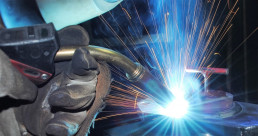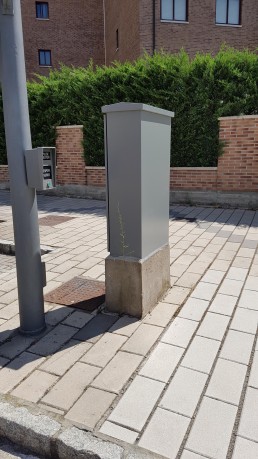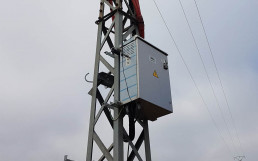How new technologies are transforming the machining industry
We live in a world that is advancing by leaps and bounds and this affects all sectors. The machining sector was not going to be less and at Delinte we strive every day to integrate new technologies in all our processes, such as the manufacture of metal electrical cabinets, shelter type cabinets, sample racks, etc. Our goal is to improve the quality of our products and to offer better services.
Read more
Metal transformations: what work do we do?
At Delinte we specialize in precision metal transformations. We work for sectors as diverse as electrical, railway, environmental control, defense, instrumentation, industrial, analytical control and also civil works. Since our beginnings we have specialized in the manufacture of metal cabinets and panels as well as analysis or instrumentation cabinets.Read more
Precision welding: TIG welding and MIG welding
In Mecanizados Delinte we manufacture all types of products, adapting them to the needs of our customers and their specific sector. Whether the job is to create a metal electrical cabinet or control room consoles, welding is a basic technique. There are a multitude of styles and techniques that we can employ. So that you know a little more about them today we wanted to focus on two of them: TIG welding and MIG welding.
Metallic solutions for traffic control
Traffic can be defined as the transit of people, animals or vehicles on the roads. In order to ensure a smooth and orderly flow, a series of rules and limitations are established to regulate and control it. Various aspects related to this sector, such as access control cabinets, have become part of our daily lives. However, in large cities, their increase can sometimes cause serious problems, such as loss of time, pollution, etc. Signals and traffic control try to solve these problems as much as possible.Read more
The safety of ATEX enclosures
When building components for our customers' projects, Mecanizados Delinte takes into account several factors, from usability to safety. It is especially important in equipment such as metal electrical cabinets. For this reason, all European Union countries follow regulations for components or equipment that may be used in potentially explosive atmospheres or environments. Today we want to focus on the one that affects one of them: ATEX cabinets.
The advantages of steel versus GRP fabrication
Steel is one of the most widely used materials in the manufacture of structures, equipment and metal parts, such as access control cabinets. Nowadays, new technologies are creating materials that are gaining ground in their use, such as GRP, but at Mecanizados Delinte we continue to bet on the advantages of steel as a fundamental material for our products.
ISO 9001 and EN 15085 certifications
When it comes to prove the worth of a company like Mecanizados Delinte, we have our experience and the projects developed throughout our history. However, there are other objective aspects that speak of our work, such as international recognition. We are going to talk about them today, specifically about the ISO 9001 and EN 15085 certifications that guarantee the quality of the companies that carry out welding processes for trains.
How is electricity generated in trains?
Since the end of the 19th century, the history of electricity and the history of trains have run parallel. Electricity is a fundamental resourcein the development of modern society that we often take for granted. However, the correct obtaining and transformation of this energy depends on whether we have electricity in our homes or the operation of one of the most used means of transport for passengers and goods, such as the railroad.Read more
How to regulate traffic remotely
Urban traffic has a direct impact on the quality of life of the inhabitants of large cities. It is evident that the process of urban population growth continues to increase, creating new population spaces on the periphery of cities. This brings with it an increase in the number of trips and daily commutes, which of course results in higher energy consumption and increased pollution.
For this reason, almost all major cities have vehicle counting systems and some essential elements to regulate traffic to try to make it as smooth as possible: traffic lights.
Traffic lights are fixed signaling elements consisting of three lights: red, amber and green according to color conventions, through which traffic flow is regulated. On December 9, 1868, the first traffic light was installed in London following the design of John Peake Knight. It needed a policeman to activate it. Until relatively recently, traffic lights regulating traffic at intersections followed fixed patterns.
Today, thanks to technological advances, most cities have implemented variable-action traffic light systems that regulate the timing according to the traffic density at any given moment.

The traffic light system in large cities
We must understand that traffic lights in a city do not act in isolation, but are connected to a large network that is controlled from a central office. From this location, the correct operation of the traffic light network and the general traffic conditions in each area of the town is regulated, and the user can interact with the different equipment at any time to change the programming if necessary.
The entire network of traffic lights in the cities is connected to monitoring software, so that if there is damage at an intersection, the control center receives an alarm that pinpoints the location of the problem. At each intersection where there are traffic lights there is a local controller, which is a kind of electronic programmer that coordinates the traffic lights at the respective intersection. It is the real control brain of the intersection, in charge of deciding the timing according to traffic volumes, pedestrians or predetermined parameters calculated on the basis of traffic studies.
The controllers are equipped with a control card where the programming of the intersection is recorded and also have software that allows connection to the central computer. Obviously, installing this equipment at street level means that it must be located in a secure space that allows it to be protected from atmospheric agents and vandalism. Delinte has been a reference company in the construction of road signaling cabinets for more than 30 years. In fact, lately we are also specializing in cabinets for SMART-CITIES management and control. Our cabinets are made of galvanized steel or stainless steel and have passed the most rigorous tests for resistance to water, dust and maritime environment.
Electrical metal cabinets and access control cabinets are some of the products most demanded by the companies we work for. To contact us simply call 916 77 03 64 or fill out the form on our website and we will contact you to inform you and provide you with the appropriate budget.
The importance of safety in electrical panels
Electrical panels are one of the key parts of the electrical installation. They contain the energy protection and control elements. The electrical panel organizes the entire electrical system, distributing the power that reaches the different elements that are part of the installation.
Thanks to the electrical panels, the possible risks of overloading the electrical network are minimized and short circuits are avoided. That is why it is very important that all panels are equipped with protection switches that automatically shut down the power supply in case of electrical accidents.
In an electrical panel there are different types of switches, each one with a specific function within the installation. Switches, in turn, are usually organized into different types of blocks.
In order to be able to safely handle the installations and machinery as well as the respective equipment in the electrical cabinet, it is necessary to have the means to electrically isolate the power and control circuits from the general power supply network.
This function, which is called switching, is carried out by different specific devices such as disconnectors or switch disconnectors and switching functions integrated in multi-function devices.
All types of receivers can suffer electrical accidents, either by overvoltage, fall, short-circuits, etc,. or mechanical type, such as rotor draft, overloading, etc. To prevent these accidents from damaging components or disturbing the power supply network, starters must include protection systems against short circuits and overloads. This is in addition to specific devices such as fuse disconnectors, circuit breakers, protection relays and measuring relays, as well as specific functions integrated in the multi-function devices. All these elements are integrated in the motor center cabinets.

Specialists in the manufacture of customized electrical panels.
In DELINTE we specialize in the manufacture of metallic electrical panels for high, medium and low voltage. We have the capacity to make series of large number of units as in the case of some of our main customers and, of course, they are cabinets designed and manufactured following the indications and requirements of each customer.
We manufacture from modular cubicles to complex switchboards and electrical cabinets. In terms of materials, we mainly use galvanized steel, which we then paint, or stainless steel (in any of its qualities).
To contact us simply call 916 77 03 64 or fill out the form on our website and we will contact you to inform you and provide you with the appropriate budget.








